Noodle is a number puzzle played on a square grid. There’s a little bit of calculation involved, but not as much as something like Number Cross or Calcudoku!
In a hurry? Jump to: Rules / Tips / Worked Example / Download Free Noodle Puzzles / Books
Here’s what a small Noodle puzzle looks like:
The objective of Noodle is to place numbers onto the grid according to the following rules:
Here’s what the earlier example looks like once solved:
Solving these puzzles involves elimination and some simple calculations. Here are some tips to help you get started. Below we’ll work through a sample puzzle from start to finish to see how to apply them.
Let’s put all of that into practice and solve a puzzle. This is a very simple level 1 puzzle, so it’s easy to follow along with and does not involve logic chaining or thinking ahead. This example isn’t intended to show the most efficient way of solving the puzzle, but is to demonstrate the strategies we can use to solve Noodle. This is just one way of getting to the solution.
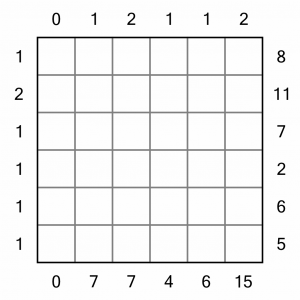
This is the puzzle we are going to solve. As mentioned, it’s an easy level 1 puzzle, just enough to get the idea, not to stretch our brainpower to the limit!
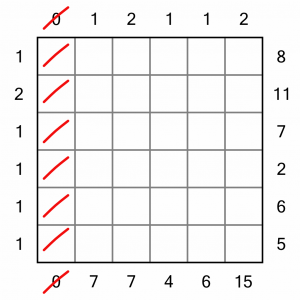
As we have a couple of zeros here, we can immediately eliminate the first column. It cannot contain any digits, so we can strike through all the cells in that column.
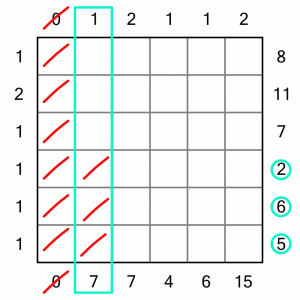
Let’s move onto the second column. The top number tells us we must place a single digit in this column, and the bottom number tells us that the contents of the column must add up to 7. In other words, we know we have to place a single 7 somewhere in the column. Therefore, we can eliminate any cells where putting in the 7 would bust a row. As we can see, none of the bottom three cells can contain the seven, as they belong to rows that add up to 2, 6, and 5. We can put strike marks in to eliminate them.
The top three cells could all potentially hold the 7, so we’ll have to come back to this column later.
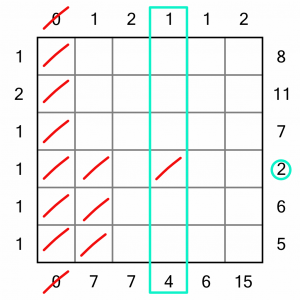
We’ll finish looking at the ‘1’ columns, as they give us more easy eliminations. Here we know we have to place a 4, so we can eliminate the cell in the row that sums to 2…
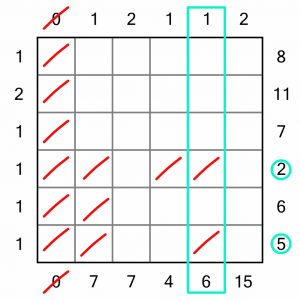
…and in this one we must place a 6, so we can eliminate the cells in the intersecting 2 and 5 rows.
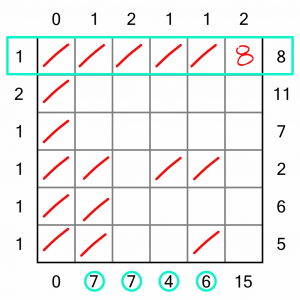
Now we can turn our attention to the rows. We must place a single 8 in the first row. We’ve already eliminated the first cell, and in fact we can eliminate the next four as to put an 8 in any of them would bust the totals for the intersecting columns. That just leaves the last cell, so we must put the 8 into that.
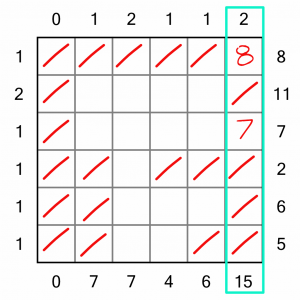
Let’s take a look at the end column now. The top number tells us we need to place two digits, and the bottom number says they must add up to 15. We’ve placed the 8, so we know the second digit must be a 7 (because 8+7=15). As there’s only one cell that can take a 7, that’s where we must put it. We can eliminate the remaining cells in that column, which will help complete the other digits.
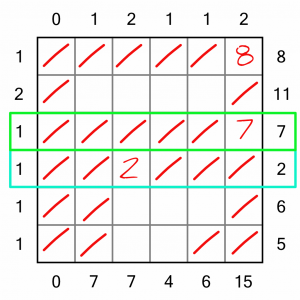
The 7 we just placed means that we have completed the row in the green box, so we can eliminate all the remaining cells in that.
As we only have one free cell in the row in the blue box, we can place the 2 that is required in that row.
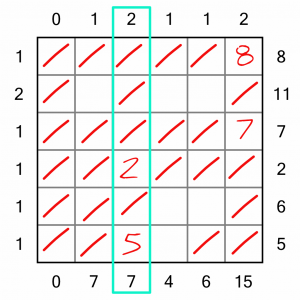
The knock-on effect of placing the 2 is that we now know we must place a 5 in this column. That’s because the column requires two digits that add up to a total of 7. There’s only one valid cell to put the 5, so we place it and eliminate the remaining cells.
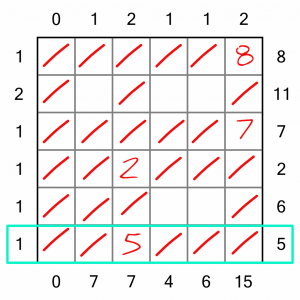
For completeness, we can eliminate the last cell in this row as we’ve complete it.
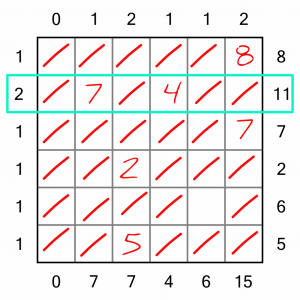
Let’s take a look at this row. We can solve it using simple arithmetic. We need two digits, they must add up to 11. From the three available, we must use the 7 and the 4. Placing these digits completes a couple of columns, too.
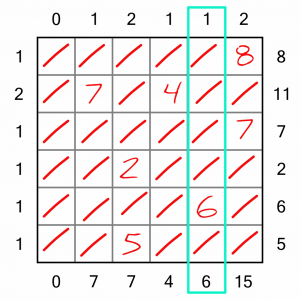
Only one digit left to place, and it’s easy because it’s the only one left! That’s it, puzzle solved.
Obviously that was a very simple example. It’s a starter puzzle, useful for getting to grips with the rules. If you want to try something harder, check out our free taster pack below – it includes a couple of easy puzzles like this, and some harder ones, too. And if you want even more, find our selection of Noodle books at the bottom of this page.
Ready to have a go yourself? We’ve put together free taster pack with a couple of Level 1 puzzles, and a couple of harder ones, too. Download the PDF below. Solutions are included so you can check your results.
Click Here To Download The Taster PDF
Would you like even more Noodle? We’ve got you covered!
Puzzle Weekly Presents: Noodle is a collection of 120 puzzles set over seven levels of difficulty. Grab a copy here.
Got a Kobo? We’ve got Noodle puzzles for that too! Noodle for Stylus Devices presents 100 puzzles over five levels, and is designed especially for Kobos with stylus. Find out more here.